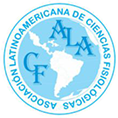The goal of the Physiological Mini Reviews (PMR) is to provide a concise original summary of a particular field in a manner understandable to physiologists working in any area. Most Mini Reviews are by invitation, and subjects are chosen by the PMR Editors. Nevertheless, spontaneous contributions are welcome.
All manuscripts should be sent in Microsoft Word, in Times New Roman, size 12, except for the title and filiation (see below), with a maximum of 3000 words –including 150-200 words of the abstract–, 35 references and 3 figures. All manuscript should be written in English.
Manuscripts for PMR Education can be written either in English or Spanish and follow the same guidelines used for PMR manuscripts. They have to provide an abstract in Spanish and English.
Manuscripts for PMR special issues “Time line of Physiological Discoveries” should be written in English and follow the same guidelines used for PMR manuscripts.
The authors are free to organize the text of the Mini Review in the way they believe is more convenient for a correct description and understanding of the subject. However, from 2013 the Editorial Committee has decided to unify certain aspects of the Mini Reviews as follows:
Title: The title should be written in capital letters, Times New Roman font size 16 bold and be centered in the page.
Authors: Below the title. Names (in bold, Times New Roman 12) and filiation (Times New Roman 10). Example:
John J. Wolff1 and Charles Maier2
1. Center on Pharmacogenomics, Department of Psychiatry and Behavioral Sciences. University of Miami Miller School of Medicine, Miami, FL 33136
2. Experimental and Clinical Research Center, 13125 Berlin, Germany
Abstract:150-200 words, in English and Spanish
Keywords: 3 to 5 keywords below the abstract, in English and Spanish.
Text: Sections: Freely organized by the authors. Times New Roman font size 12, single space. Figures included in the text. Due to the nature of the Minireviews, it is recommended to include 2-3 explicatory Figures. All pages should be numbered at the bottom right). Abbreviations must be defined at first mention.
References: Maximum 35 references. Cite references in numerical order according to first mention in the text.
All authors must be listed in each reference. Do not use “et al.” The one exception is for references with 10 or more authors; for these, please list the first 10 authors followed by “et al.”
Reference style is as follows:
Journal references:
Zhao W, Waggoner JR, Zhang ZG, Lam CK, Han P, Qian J, Schroder PM, Mitton B, Kontrogianni-Konstantopoulos A, Robia SL, Kranias EG. The antiapoptotic protein HAX-1 is a regulator of cardiac function. Proc Natl Acad Sci U S A. 2009; 106: 20776-20781.
Book citations:
Gourdie RG, Litchenberg WH, Eisenberg LM. Gap junctions in heart development. In: DeMello WC, Janse MJ, eds. Heart Cell Communication in Health and Disease. Boston, Mass: Kluwer; 1998:19–44.
Mini reviews should be sent by e-mail to the following address: pmr@safisiol.org.ar
Peer Review:
Each contribution is reviewed by at least two experts (single-blind assessment) who are either members of the Editorial Board or are recruited by Board members. The revision is simple blinded. The Editor-in-Chief makes the final acceptance/rejection decision on manuscript.
Copyright
Authors need NOT contact the journal to obtain rights to reuse their own material. They are automatically granted permission to do the following:
- Reuse the article in print collections of their own writing.
- Present a work orally in its entirety.
- Use an article in a thesis and/or dissertation.
- Reproduce an article for use in the author’s courses. (If the author is employed by an academic institution, that institution also may reproduce the article for teaching purposes.)
- Reuse a figure, photo and/or table in future commercial and noncommercial works.
- Link to the journal site containing the final edited PDFs created by the publisher.
Revision of manuscripts:
Manuscripts are preliminary examined by the Editorial Committee and assigned to at least two anonymous expert reviewers of the Editorial board. When necessary, manuscripts will be evaluated by reviewers external to the Editorial Board with the required expertise on that particular topic.
Misconduct:
If editors suspect misconduct (including plagiarism, citation manipulation, and data falsification/fabrication, among others) by authors, reviewer’s editorial staff or other editors then they will take action on both published and unpublished papers. Editors will ask a response from those accused, and if this response is not satisfying, they will ask the employers of the authors, reviewers, or editors or some other appropriate body to investigate and take appropriate action.
Publication Ethic
This journal supports the code of conduct set out by the Committee on Publication Ethics (COPE) (https://publicationethics.org/).
Digital Archiving and Preservation Policy
The digital content of the journal is extremely valuable and measures are in place to ensure both its current accessibility and long-term preservation. The preservation policy includes Website archiving. All of our electronic content (website, manuscripts, etc.) is stored on two different sources. Content on one server is online and accessible to the readers. The copy of the same content is kept as a backup on two other sources. In case of failure of one server, any one of the other sources can be made online and website expected to be accessible within less than 24-36 hours.

